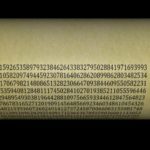Friday, July 28th, was a great opportunity to enjoy the beauty of our planetary system. Here in Switzerland we had a starry night with all the prominence of our solar system showing up during the evening. Even with my old and shaky telescope I could have a look at the phase of venus, the reddish surface of Mars, the big moons of Jupiter and the rings of Saturn. But the highlight was certainly the longest lunar eclipse of this century. The sky was still quite bright at the beginning of the eclipse, but during the second half it was dark enough to fully appreciate the red shimmer of the shaded moon.
How many digits of pi are needed for a successful prediction of a lunar eclipse?
It’s amazing how accurately eclipses can be predicted even hundred’s of years in advance. And the value of pi is one of the ingredients to make these calculations possible. Today, I wondered about how many digits are required to successfully predict a lunar eclipse. To get a rough estimation for an answer, I installed pyephem, a python package for astronomical calculations on my computer. I wrote a little script to calculate the angular separation of the sun and the moon for this Friday’s eclipse for an observer, which would be located at the centre of the earth. As a result, I got a value of about 179 degrees and 49 arc minutes for the maximum of the eclipse. This is very close to 180 degrees and one of the the reasons, why this lunar eclipse was the longest of the century. Afterwards I modified pyephem (and its underlying C library) to use less accurate values of Pi. The resulting angular separation for the same location and time are shown in the table at the bottom of this page. For an eclipse to take place, the angular separation has to exceed about 179 degrees. Therefore we need about five significant digits of π for a successful prediction of the eclipse.
Three arguments for a theistic world view
Besides an accurate value of pi, successful predictions of eclipses have some interesting requirements that challenge a naturalistic worldview. Let’s have a look at three of them:
- A universe ordered by regular laws of nature
- A space-time with exactly one time dimension
- Understandable laws of nature
An ordered universe
First of all, nature must reliably obey to some kinds of laws of nature, in our case to the laws of kinematics and gravity. There is no reason to believe that our universe could not be completely chaotic. If you find it difficult to imagine how a chaotic universe could look like, consider the following thought experiment. Let’s imagine that we take a snapshot of the solar system every hour and keep doing this for several years. If you then looked at the snapshots in a random order, you would find that the moon would arbitrarly jump between different positions. In such an universe it is completely impossible to predict lunar eclipses. So the obvious question to ask is: why do we live in a nicely ordered and not in a completely chaotic universe? The Christian answer is: Because the universe was created by God, who loves the order (e.g. 1Cor14v33).
One time dimension
Even if we take the existence of the laws of nature as granted, we can only predict lunar eclipses if our universes has the right number of time dimensions. As pointed out by Max Tegmark, more or less than one time dimension makes predictions in general impossible, because the partial differential equations to be solved become ultrahyperbolic. So we’re quite lucky to live in a universe with exactly one time dimension, because life would not be possible without the possibility of planning the future! As a naturalist, you don’t have much other choice than to accept this as brute fact. But the Christian knows: God made the earth as a place, where people can live and not as an empty desert (Isa45v18).
Understandable laws of nature
But even a universe with the correct number of dimensions and with reliable laws of nature is not a sufficient condition for predicting lunar eclipses. Another requirement is, that the laws of nature are simple enough to be understood by our limited intellectual capabilities. Although accurate calculations are difficult, Newton’s law is suprisingly simple, depending only on the masses of the involved bodies as well as on their distance. Why does the attracting force not depend on the chemical composition of the planets, their shape or their temperature? It would be easy to imagine a gravitational law depending on fifty or more physical properties. Furthermore, the mathematical form could be much more complicated than a simple inverse square law. In such a case, humanity would have severe difficulties to discover any laws of nature and to make use of them. In a naturalistic setting, it must look like a lucky coincidence that we live in a universe with discoverable laws of nature. In the Judeo-Christian context, it’s not a surprise, since God wanted humans to creatively make use of his creation (eg. Ex35v31).
| Pi | Angular Separation between Sun and Moon [degrees:arc minutes] |
| 3.1 | 91:35 |
| 3.14 | 176:18 |
| 3.141 | 178:36 |
| 3.1415 | 179:42 |
| 3.141592653589793 | 179:49 |






Comments by Pipi